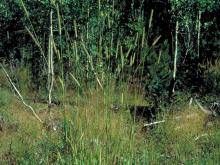Wildflowers, Grasses and Other Nonwoody Plants
Media

Species Types
Scientific Name
Phleum pratense
Description
A native of Europe, Timothy is a common cool-season pasture grass and occurs in a wide variety of open or disturbed habitats. It is one of the worst causes of hay fever in the late spring and early summer.
Media

Species Types
Scientific Name
Elymus virginicus
Description
Virginia wild rye can be identified by its bristly seed heads, which are held erect and whose bristle-like awns stay straight. This is a common native perennial tuft-forming, cool-season midgrass usually reaching about 2–4 feet in height.
Species Types
Scientific Name
Bromus pubescens (formerly B. purgans)
Description
Several species of brome grasses are found in Missouri. Canada brome, or hairy woodland brome, is one of the few that are native. It grows to 4 feet high, and its open flower clusters have drooping spikelets.
Media

Species Types
Scientific Name
Dactylis glomerata
Description
Orchard grass is a perennial, clump-forming, cool-season grass introduced to American pastures long ago. Identify this common roadside grass by its bluish-green leaves, flattened stalks, and dense, flattened, bushy clusters of spikelets.
See Also
About Wildflowers, Grasses and Other Nonwoody Plants in Missouri
A very simple way of thinking about the green world is to divide the vascular plants into two groups: woody and nonwoody (or herbaceous). But this is an artificial division; many plant families include some species that are woody and some that are not. The diversity of nonwoody vascular plants is staggering! Think of all the ferns, grasses, sedges, lilies, peas, sunflowers, nightshades, milkweeds, mustards, mints, and mallows — weeds and wildflowers — and many more!





















